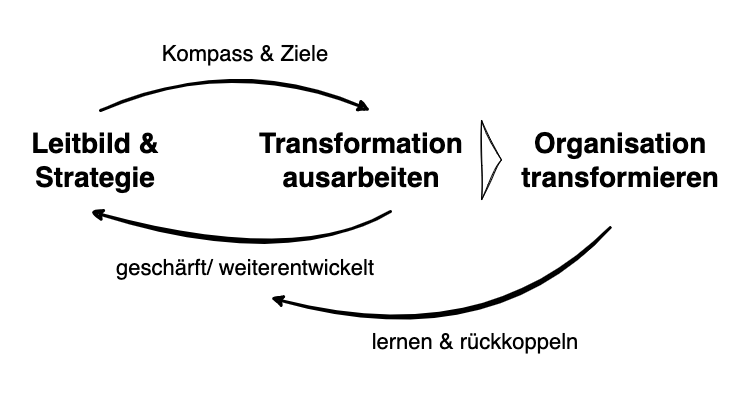successfully transform organisations
Interconnectedness, complexity and permanent dynamism are the prevailing patterns of today's world. Recent developments in AI as well as significantly changing expectations of society, customers and employees require a rethinking and sharpening of mission statements and a changed strategic positioning.
Disruptive changes in entire industries and markets are also forcing significant changes in the business and operational model, e.g. platforms and network organisation.
With a formulated mission statement and defined strategy, the first question that immediately emerges is then:
1.
How can one successfully transform an organisation in alignment with mission statement and strategy from todays state to tomorrows desired state, and what should the target state look like?
Organising the transformation of the organisation simply as the implementation of a mission statement and strategy will fall short.
Extensive transformations are associated with an order transition of the organisation and require a systemic overall understanding in order to
To avoid the Tortoise and the Hare dilemma
"We are still in transformation, but the future is always already here, and it's different than we expected"
an organisation has to address the following:
2.
How and where in the organisation do we need more agility, increased responsiveness and better internal and external senses?
Why is that? Because time plays a role and because we are always dealing with imponderables:
And, last but not least, that a sharpening or further development of the mission statement and strategy is needed usually only becomes clear when the organisation is dealing with the transformation itself, because the following question arises:
3.
Are the mission statement and strategy sufficiently and appropriately formulated for such a transformation?
Sufficient and appropriate in that the mission statement is differentiating, emotionalising and the strategy is action-guiding enough to serve as a compass for transformation.
The interaction at a glance:

And finally, the basic attitude and the degrees of freedom need to be clarified:
Of course, there are a number of suitable models for designing transformation projects.
A very suitable, contemporary framework for working out the transformation (Questions 1, 2 and 3 within the Problem Statement) is, in my view, the path compass of the systemic consultancy Andy Duke GmbH, based on decades of experience with large transformation projects with the most diverse organisations.

The term Wegekompass is a registered trademark and legally protected. The trademark owner is systemic consulting Andy Duke GmbH.
The design is in the foreground, releasing energies and generating positive emotions for the path and the goal, thus building a positive arc of tension.
An intensive examination of the mission statement and strategy takes place, the view is freed up for previous patterns of thought and action in the organisation, and for what makes the organisation tick. This examination alone leads to changes in the organisation.
Working with the route compass also provides necessary clarity and insight, because:
The framework forms the framework and provides orientation in the process; specific tools can then be used for individual questions, such as Simon Sinek's Golden Circle, SWOT analyses, classic market and competition analyses, a Business Model Canvas, the Digital Maturity Level etc.
25 years of experience in project management of complex, company-wide or cross-company projects, from IT and ERP migration and implementation projects in the early years, to M&A and strategy projects and company-wide transformation processes. X-functional, X-business & IT, international, extensive group experience, impact at all levels